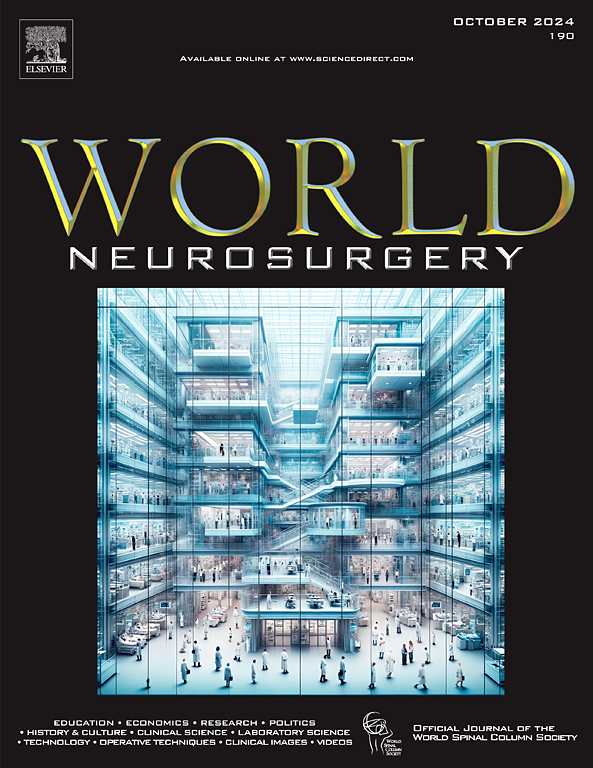Surgical Strategy and Decision-Making in Recurrent Atlanto-Axial Dislocations: The Role of Traction
IF 1.9
4区 医学
Q3 CLINICAL NEUROLOGY
引用次数: 0
Abstract
Objective
To analyse patients with recurrent atlanto-axial dislocation and give a criterion of an ideal patient who can benefit from redo surgery.
Methods
This retrospective study was conducted in a tertiary care center, which included 20 patients who failed atlanto-axial surgery from January 2013 to June December 2021. They were evaluated using X-ray, computed tomography, and magnetic resonance imaging examinations, and their clinical data were accessed from the hospital’s medical records department and the picture archiving and communication system. They were given a trial of traction to look for clinical and/or radiological improvement. Those showing clinical and/or radiological improvement underwent redo fixation. The operative steps involved removing joint capsules, denuding articular cartilage and joint preparation followed by reduction of basilar invagination by the combination of spacer and/or bone graft and putting screws in C1/Occiput and C2. A strut graft was placed between Occiput/C1 and C2.
Results
The mean change in modified Japanese Orthopaedic Association Scores and Nurick grade following the first surgery was statistically significant (1.00 ± 0.73, P value 0.002 and −0.15 ± 0.27, P value 0.046, respectively). On similar paths, the mean change in modified Japanese Orthopaedic Association Scores and Nurick grade following the second surgery was also statistically significant (4.25 ± 0.32, P value < 0.001 and −1.2 ± 0.11, P value < 0.001, respectively). Improper usage of constructs (31.57%), inadequate/no joint preparation (42.10%/57.90%), and poor choice of graft (100%) were the leading causes of failure of index surgery.
Conclusions
The best candidates who can benefit after redo surgery are the ones who exhibit either clinical and/or radiological improvement on the trial of traction, as the pathological C1-C2 joints are either not fused or have undergone pseudoarthrosis. Those patients who do not exhibit significant clinical or radiological improvement post-trial of traction should not be offered subsequent surgical intervention.
复发性寰枢椎脱位的手术策略和决策:牵引的作用
目的分析复发性寰枢关节脱位患者,并给出能够从重做手术中获益的理想患者的标准:这项回顾性研究在一家三级医疗中心进行,纳入了 2013 年 1 月至 2021 年 6 月期间寰枢椎手术失败的 20 名患者。他们通过X光、CT和磁共振成像检查进行了评估,并从医院的病历部门和图片存档与通信系统中获取了他们的临床数据。对他们进行牵引试验,以观察临床和/或放射学方面的改善情况。临床和/或放射学情况有所改善的患者接受了重新固定手术。手术步骤包括去除关节囊、剥离关节软骨和关节准备,然后通过垫片和/或植骨减少基底内陷,并在C1/Occiput和C2植入螺钉。结果:第一次手术后,mJOAS 和 Nurick 分级的平均变化具有统计学意义(分别为 1.00 ± 0.73,p 值 0.002 和 -0.15 ± 0.27,p 值 0.046)。在相似的路径上,第二次手术后 mJOAS 和 Nurick 分级的平均变化也具有统计学意义(4.25 ± 0.32,P 值 结论:由于病变的C1-C2关节要么未融合,要么已发生假关节化,因此在牵引试验中表现出临床和/或放射学改善的患者是再次手术后的最佳受益者。那些在牵引试验后临床或放射学症状没有明显改善的患者不应接受后续手术治疗。
本文章由计算机程序翻译,如有差异,请以英文原文为准。
求助全文
约1分钟内获得全文
求助全文
来源期刊

World neurosurgery
CLINICAL NEUROLOGY-SURGERY
CiteScore
3.90
自引率
15.00%
发文量
1765
审稿时长
47 days
期刊介绍:
World Neurosurgery has an open access mirror journal World Neurosurgery: X, sharing the same aims and scope, editorial team, submission system and rigorous peer review.
The journal''s mission is to:
-To provide a first-class international forum and a 2-way conduit for dialogue that is relevant to neurosurgeons and providers who care for neurosurgery patients. The categories of the exchanged information include clinical and basic science, as well as global information that provide social, political, educational, economic, cultural or societal insights and knowledge that are of significance and relevance to worldwide neurosurgery patient care.
-To act as a primary intellectual catalyst for the stimulation of creativity, the creation of new knowledge, and the enhancement of quality neurosurgical care worldwide.
-To provide a forum for communication that enriches the lives of all neurosurgeons and their colleagues; and, in so doing, enriches the lives of their patients.
Topics to be addressed in World Neurosurgery include: EDUCATION, ECONOMICS, RESEARCH, POLITICS, HISTORY, CULTURE, CLINICAL SCIENCE, LABORATORY SCIENCE, TECHNOLOGY, OPERATIVE TECHNIQUES, CLINICAL IMAGES, VIDEOS
 求助内容:
求助内容: 应助结果提醒方式:
应助结果提醒方式:


